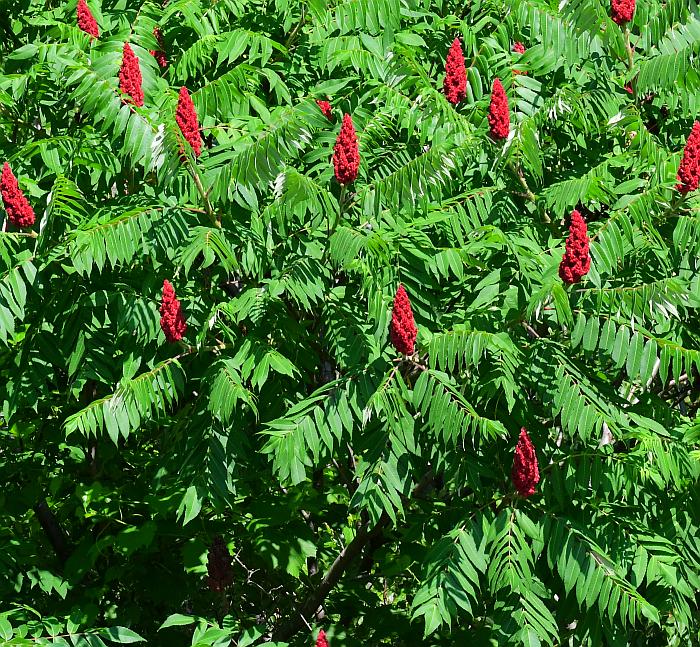Rhus typhina L.
Staghorn Sumac

Introduced
CC = *
CW = 5
MOC = 3
© SRTurner
Rhus typhina L.Staghorn Sumac | |
 |
Introduced CC = * CW = 5 MOC = 3 |
© SRTurner |
|
Family - Anacardiaceae Habit - Tall shrubs or small trees 2-6 m tall, with stout branches. Stems - Woody, to +/-8m tall, typically with a single trunk but forming colonies from stolons, with sticky sap, this quickly darkening with exposure to air. Young branches, petioles, and leaf rachis densely pubescent with woolly or felty hairs.
Leaves - Alternate, odd-pinnate, petiolate. Leaves pinnately compound, with 9-25 leaflets, 9-40 cm long, the petioles 3-10 cm long, densely woolly or felty, the rachis not winged. Leaflets 7-10 cm long, 1.0-4.5 cm wide, lanceolate to narrowly oblong, sessile or very short-stalked, the margins toothed, the upper surface dark green, glabrous or nearly so, shiny, the undersurface light green, moderately to densely hairy along the veins, also glaucous.
Inflorescence - Inflorescences terminal, dense, ovoid panicles, 7-25 cm long, 3-4 cm wide, the axis and branches densely pilose. Pistillate inflorescence smaller but much more dense than staminate inflorescence. Inflorescence branches each subtended by a long attenuate bract, these to 2cm long, 2-3 mm broad at base, densely pilose. Staminate inflorescence more strongly pyramidal. Plants polygamo-dioecious.
Flowers - Sepals 1.2-1.5 mm long, narrowly ovate, sharply pointed at the tip. Petals 5, 1.5-2.5 mm long, oblong-oblanceolate, rounded at the tip, greenish yellow, sparsely hairy on both surfaces. Style 3-parted, 0.5 mm long. Stigmas capitate, yellowish. Ovary superior, densely white pubescent. Staminate flowers with 5 stamens, these erect and exserted. Filaments whitish, 1.2 mm long. Anthers yellow, 1 mm long.
Fruits - Drupes 4-5 mm long, 4-5 mm wide, somewhat flattened, red, with dense, slender, straight, red hairs 1-2 mm long.
Flowering - June - July. Habitat - Railroads and open, disturbed areas. Also cultivated, sometimes escaping. Origin - Native to the eastern U.S., considered introduced in Missouri. Lookalikes - R. glabra, R. copallinum. Other info. - This species is very uncommon in Missouri, though very common farther northeast in the U.S. Its appearance is similar to the common sumacs, except that young stems and leaf petioles are densely hairy. The species spreads by means of stolons and can form large colonies. These colonies, bearing numerous bright red fruit clusters, are a common sight along roadsides in some upper Midwest states. The fruits of the plant persist through winter and are eaten by wildlife. The fruits are also popular with humans and can be brewed into a pleasantly tart tea. Traditionally the tea was used for medicinal purposes. Photographs taken at the Kansas City Zoo, 6-28-00 (DETenaglia); also near Goodrich, Genesee County, MI, 7-3-2022 (SRTurner). |